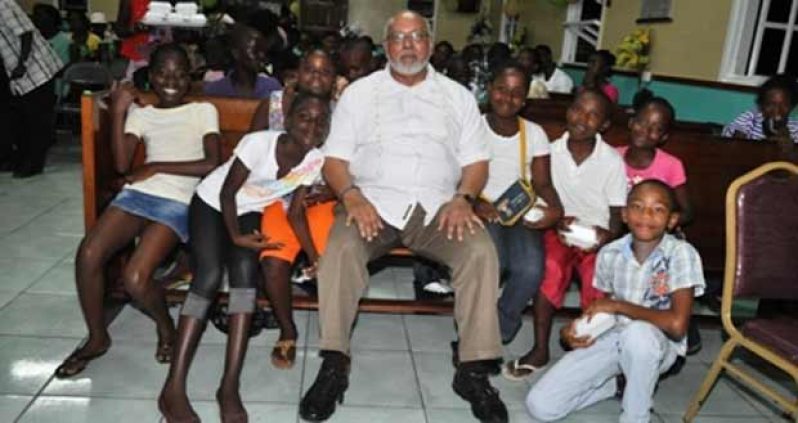This week we decided to focus on a village with a rich historical back ground, as it still oozes a distinct old world charm. While many came to mind instantly we finally settled for Den Amstel with its dusty streets, dense foliage and still charming cottages and ‘yesteryear looking’ building that lends a certain ‘in times gone by aura.’
History
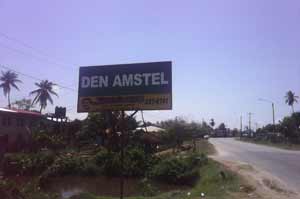
Den Amstel lies about seven miles from Vreed-en-Hoop, sandwiched between Blankenburg to the east, and Hague to the west. The village is sited on what was once a plantation of the same name. A Dutch planter called his estate Den Amstel, after the river which flows through the city of Amsterdam in the Netherlands, from where he presumably came.
The population of the village is over 3,000, mostly of African descent. The area is divided into three sections: Den Amstel Sea View, Den Amstel Housing Scheme and Den Amstel Old Road. The old road was the main means of access to the village in earlier days; however, in the year 1974, the main West Coast Demerara roadway way was constructed displacing the old road as the primary route into the community.
Overseer, now turned Chairman, George Nedd has been the area’s administrator for the past five years. He calls special meetings regularly to discuss issues surrounding his functions and those that affect the lives of villagers

According to historical revelations, Den Amstel was a coffee plantation owned by a Dutch planter named John Craig. Plantation Den Amstel was named after the two sons of Mr. Craig; his sons’ names were Denny and Amstel.
In 1945 the government established a camp site in the village. It consisted of four huts, a kitchen and a dining hall. There, youths participated in club activities including cooking, cultivating kitchen garden and cultural activities.
In the late 18th century ex-slaves pooled their resources together and purchased the plantation, having learnt that it was up for sale. During this time much emphasis was placed on Fellowship. It was considered advisable to include Den Amstel community in the record, as the two communities existed as one environment. The destiny of one was that of the other. These two communities are separated by a sideline trench.

Anyone who approached and entered the communities would view them as one village because of their geographic location and situation.
To the people of Den Amstel, a glorious heritage was passed on. A people so privileged that they are envied by their other local neighbourhoods on the West Coast of Demerara. They were the first village to hold a village council meeting and form a legislative council.
In 1838 after the abolition of slavery on August 1 the freed slaves were paid small wages. They saved part of those wages from time to time and when the owners wanted to abandon the plantation because of the many floods that destroyed the crops and made it less prosperous, 125 of the ex-slaves offered to buy with their savings. The ex-slaves became proprietors in 1854. Each proprietor had his portion of land to maintain, but this was not successful. The reason was because the people failed to keep their surroundings in a healthy condition, such as weeding the yard and keeping drainage gutters around their premises clean.
The people of Den Amstel enjoyed this service much to their convenience. Other than pedal cycles, foot, and horse and donkey carts, the train was the main means of transport. At the end of June 1974, the railway service came to an end. Many live to regret its termination. The Guyana

Transport Services Limited came into effect on July 1, 1974 and is presently at a halt.
In summation what comes to the fore is that churches played a vital role in the lives of the people in the Den Amstel/Fellowship community. The cornerstone was laid down. The Ebenezer Congregational Church was most influential and instrumental in moulding the characters in the village. Children who were born in this community are always referred to as Ebenezer boy or girl because Ebenezer carried many great personalities who in turn shaped lives for generations to come.
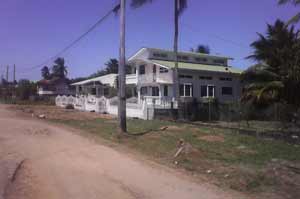
Chatting with the village Chairman
As luck would have it I bumped into the Village Chairman, George Nedd who had stepped out to a shop on the public road to acquire some phone credit. Not knowing who he was I had already flashed a photo of him relaxing comfortably as he enjoyed a telephone conversation, only to realise this was the man I was seeking as indicated by a snack vendor who operated her business close by.
As we settled down for an enticing talk session, the jovial and very pleased Nedd related that the community is home to over eight churches, and is home to many schools, including a play school, a nursery school, a primary school and a technical vocational centre.
He noted, however, that unlike the Den Amstel of old, which relied heavily on farming as an economic activity, only a small number of persons farm these days, with most preferring to open businesses, or go outside of the community to find jobs.

Commenting on the level of entertainment in the village, Mr. Nedd noted that while entertainment seems not to be gathering momentum in Den Amstel, a football craze has however seized the location, bringing to life fiery clashes amongst the Den Amstel, Slingerz, Pourdereyn and other village teams. He noted that at one time cricket was the order of the day and that Den Amstel at one time had one of the strongest teams however. Sadly however, many team members have relocated to greener pastures thus causing a distinct decline in the sport.
There is no nightclub or vibrant entertainment hotspots in the village according to Mr. Nedd, save for the Bo Bo Hang Out Bar that would normally host Karaoke Nights, especially on weekends.
According to Mr. Nedd villagers are quite satisfied with hosting occasional house parties, especially at Easter or In August month with many overseas based Guyanese return for the traditional Emancipation celebrations.
The Chairman noted however that there is more input is needed in the areas of youth development, and production avenues are needed for youths to channel their energies.

According to Mr. Nedd the issue of unemployment continues to be a nagging factor in the village since the job market has already absorbed trained professionals and ready employment is not created. He explained that there is a need for cottage industries in the village to absorb or possibly eradicate this issue.
Den Amstel of yesteryear
Many years ago Den Amstel was just a very under developed settlement with a few scattered houses and dense bushes and foliage. According to the Village Chairman, the village has sustained its symbolic after slavery appearance for ‘donkey years’ before slowly transforming into the still evolving village it is today.
Nedd explained: “The community is still improving and developing gradually and new structures are popping up here and there. This in itself is lending a somewhat modern appearance to the village, but its historical features are certainly not fading. Many years ago Den Amstel was not developed and had a kind of simple and humble ‘pheasant dwelling’ atmosphere. But remigrants continue to pool their resources and are returning home to build sophisticated structure which is slowly changing the appearance of the village from ancient to modern”.
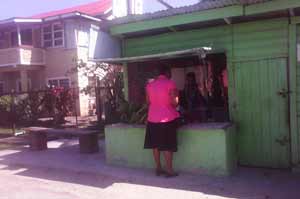
Challenges
Despite its appealing aura of simplicity and humility residents appear to be plagued with a few challenges, particularly bad roads, not so perfect drainage, and lack of adequate lighting.
Speaking on such issues was a group of resident that were headed by farmer, Winston Rockcliffe who was very displeased as it appeared. “Life is good in the village but it could certainly be made more comfortable if authorities would look into the areas of drainage, street lights and the bad roads. Roads in this village are in a poor stage with large pot holes that become water logged when the rain falls. The drainage is very poor and villagers have to engage in self help projects to get the drains around their homes clean and tidy. There are so much weed and plants in the drains that it sometimes completely stops the flow of the water. That aside, the lack of street lights in some sections of the village certainly causes much discomfort for villagers”
According to Mr. Rockcliffe, villagers had pooled monies and purchased street lights which they placed on GPL power poles to get proper lighting.

He said that not long after GPL representatives came and removed the lights citing that it was illegal to have them there, and has not brought any to replace them, leaving sections of the village in darkness.
Even as villagers were lamenting these woes, Chairman George Nedd related that drainage in the village is fairly good since they benefit from the funded Water Users Association (WUA). He however noted that a few internal drains are clogged since they are no personnel to clean them. He added the Drainage and Irrigation team in the village is very small and that males in the village are not too keen to be employed or engaged in ‘drain cleaning exercises’ thus forcing many residents to resort to self help efforts to keep their drains free.
Mr. Nedd said that however they have been promised assistance from the Region 3 Regional Democratic Council which has acquired a few mini-excavators. He noted that the main canals are however in fairly good shape.

Villagers continue to lament the state of the roads in Den Amstel, which they say are damaged by heavy vehicles, particularly trucks traversing many of the access streets that lead into the village. Some residents are suggesting that barriers be built at the very entrance to the streets that will prevent these heavy trucks from accessing certain areas and damaging the roads.
Some residents are also lamenting that the Guyana Water Inc. (GWI) recently dug up an access road to do repairs to pipelines, and something seems to be amiss. A few farmers indicated that since the road was dug up and the repairs done, water is now seeping from that area into their yards and gardens, especially when the water pressure is most high.
Church Influence
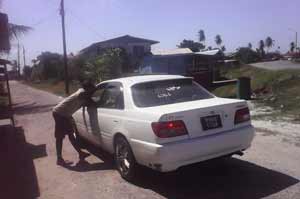
Church influence played a dominant role in the lives of the people within this community. They then established themselves where the population was the thickest and where bright prospects pertaining to religious and cultural development existed. The development of the political environment grew out of circumstances, which unveiled themselves. As a new people became engrossed with new aspirations, the horizon was necessarily limited. Gradually as education spread, the avenues for expansion and development widened. What appeared distant eventually came within grasp as time rolled on.
Missionaries then are to be given significant mentioning, as they were the first to diffuse edifying influence and scholastic achievement. They trained teachers who were destined to do work among the people. The association between the church and the school is one of long standing. From the teaching profession came the first set of men who went off to study Law and Medicine. Tribute must be paid to those early teachers who proved successful because of the training given to them. They excelled when they entered other professions.
Teachers
Teachers have played a prominent role it the intellectual development of the village. They took up what was started by the church. When the churches could not carry the burden of providing universal education, it handed over to the State the privilege of financing it. Some of the village’s prominent teachers were: William Elliot Lewis, a Barbadian; Mr. Adolphus Medas, Hubert Archibald Boston, H.S. Jackson and L.B. Russell.
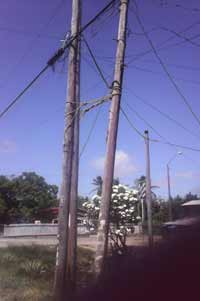
Leadership
Two outstanding village leaders were Mc Farlene Corry and Joseph Waterton Jackson. The former inaugurated the Village Chairmen’s Conference and the latter was among the founders of the West Demerara Chairmen’s Union.
Den Amstel was declared a village in 1892. The village chairmen from that time were as follows: 1892-1894 – Mr. S. C. Thorpe; 1894-1895 – J. Herbert; 1895-1922 – J. Mc Farlene Corry; 1923-1943 J.W. Jackson; 1943-1945 J.T. Roberts and 1945 – W. A. Bart. Mr Mc Farlene Corry was the first local chairman of the Den Amstel/Fellowship Village District.
Mr. Lionel Langevine was the last of the chairmen who served under Den Amstel/Fellowship Village Council. After which the Local Authority changed to Neighbourhood Democratic Council.
The Local Government Board with its quest for dynamism used all the necessary resources to steer the villages in the best interest of the reigning administration. So that when villages reached the stage that proved they were able to accept greater responsibility, an elastic system of government would undoubtedly allow provision for the transfer of that responsibility.
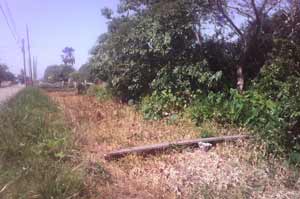
Congregational Ministers
During the periods 1817-1926 numerous events took place which serve to inform and educate generally. In 1817, Reverend Richard Elliot started the missionary work at Ebenezer Congregational Church. This led to a Mission house being built at Plantation La Jalousie in 1819. Probably because of his influence and the role he played in the Ebenezer Church, Reverend Elliot in 1823 was arrested and confined in the Dutch Reformed Church. This church known today as St. Andrew’s Church, was occupied by government forces. After being released in 1824 he returned to England, this led to the closure of the mission.
The year 1829 marked the rebirth of the mission by Joseph Ketley, after having been closed which for six years. In April 1920, Michael Lewis, Ketley’s brother-in-law, took charge. When one Reverend Wray left Berbice for England in 1831, Lewis took charge temporarily. Ebenezer Church was then left without a minister.
James Scott arrived on December 31, 1831, and his family joined him in 1832. Mrs Scott died in 1836. In 1838 Reverend Scott returned to England and returned with a second wife in 1839.
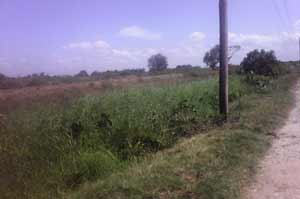
The completion work on the church was done by Scott in 1843. A school called Ebenezer Congregational was built in that very year. Many of the villagers attended this school. Reverend Scott returned to England with his wife in 1849. She died in 1852 and again he retired to his place of birth in 1868.
Another minister was appointed to Ebenezer in 1865, but took office in 1867. His first wife died in 1847, and he married for the second time in 1849 to one Jane Buchanan Laing of Den Amstel Village. He was ordained in 1853 and later died in 1888. Reverend James Lampard Green succeeded Mr Foreman and renovated the church and installed a pipe organ. He was the last of the London Missionaries Society.
The first local Pastor who took charge of Ebenezer Congregational Church on March 1, 1896, was Thomas Burchell Glasgow, ATS. He married one month later to Helena B. Lawrence, he was said to be very brilliant and scholarly. T.B. Glasgow died in 1924. In 1929 David W. Hamilton Pollard, B.A. filled the vacancy and left in 1942. The year 1944 Adam T. Johnson took charge of the congregation.
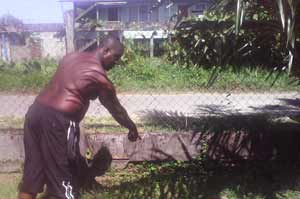
The Streets of Den Amstel
As one approached from the old public road of Den Amstel, there is Statue Street, which got its name due to location of a Statue, which was erected at the head of the street in the year 1897. It is engraved V.R., which means Victoria Reigns. This landmark reminds one of the 50th reign of Queen Victoria. Then there is Wellington Street, which is on the other side of the public road, which was named after Nellie Wellington, the first woman to sit on the Legislative Council of Den Amstel/Fellowship. Then there are Young Street named after Emily Young, a registrar of births and deaths. Langevine Street, named after a prominent proprietor and member of the Council, Gray Street named after Nana Gray, also a prominent proprietor.
Ebenezer Congregational Church
The cornerstone was laid on the 25th April 1955, by his Excellency, Sir Alfred Savage, the then Governor of British Guiana. In 1956 this church was built at Den Amstel to replace the one at Blankenburg, which was, then in a state of disrepair. The Reverend Dr. Carlyle Miller was the minister during that time.
Conclusion
It may be a village with some adverse challenges, but tell me of one village which has none. Development is surely impending and in time things would work out for the best. In the mean time, lets not ponder on the few setbacks that we may encounter, but think of the rich history and the alluring ambience of this ‘Old World Haven’. Take a trip their and enjoy the fresh, crisp Atlantic breeze as you feast on an abundance of succulent fruits which can be found in Den Amstel. See you there folks.
By Alex Wayne




.png)


